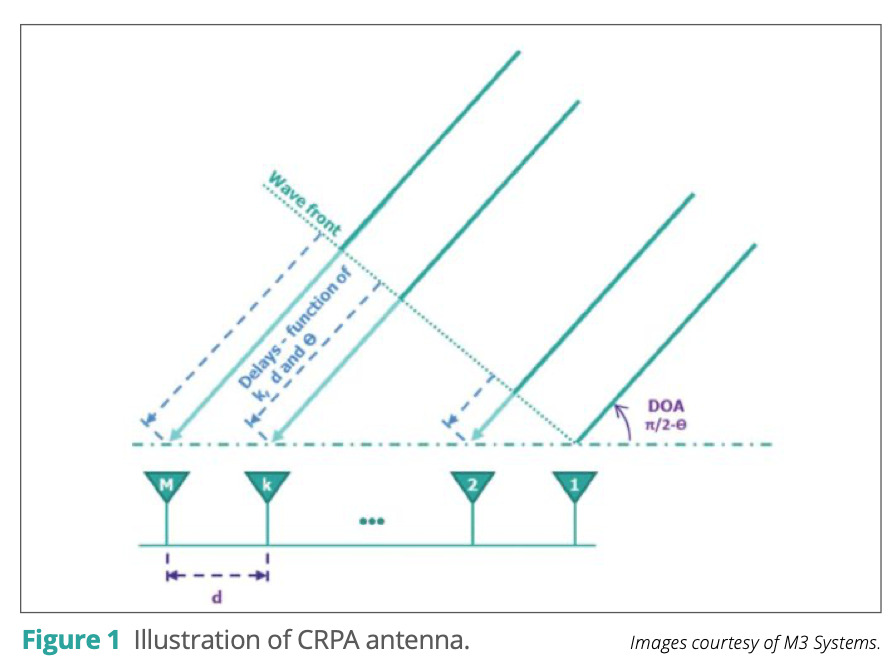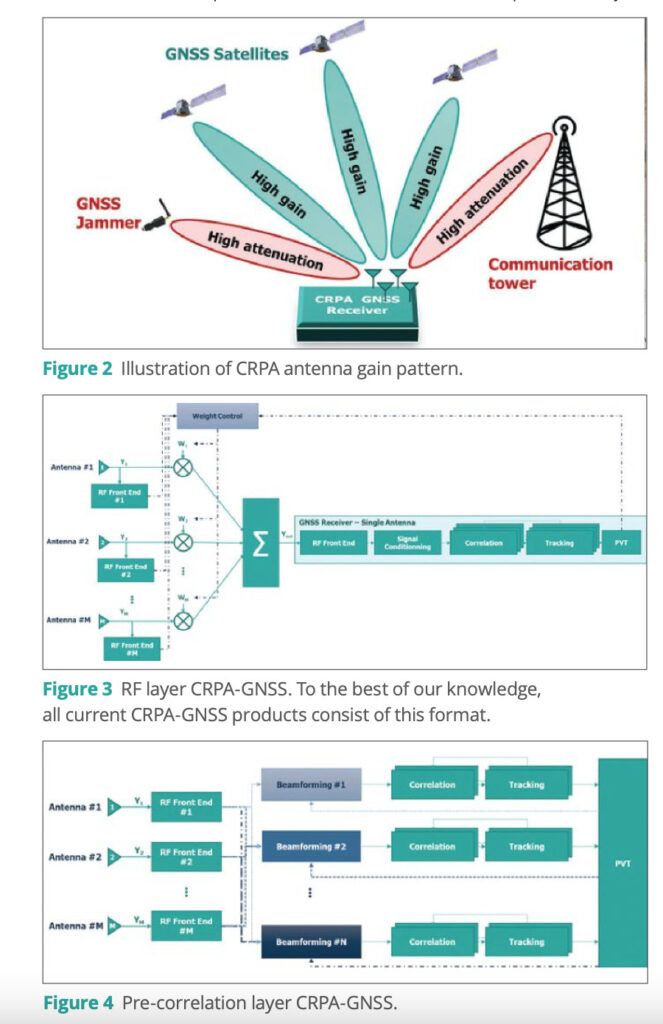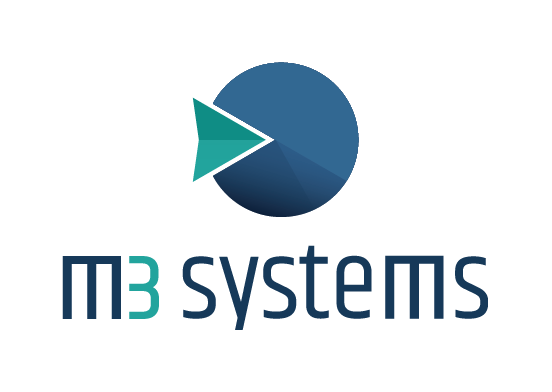Now available to civil as well as military users, controlled reception pattern antennas boost resiliency for many GNSS applications.
Since 2015, controlled reception pattern antennas (CRPAs) have emerged in the civil applications market, where the need to combat GNSS signal jamming and spoofing has grown exponentially. Previously available only to authorized military users, these powerful antennas can significantly increase resiliency for many GNSS applications, from aviation to critical infrastructure to autonomous vehicles and drones to the monitoring of heavy-duty freight shipments.
As a particular example, consider Galileo Public Regulated Service (PRS) receivers aboard navigation systems and platforms, equipped with GPS/Galileo-compatible CRPAs. Galileo Open Service (OS) receivers in sensitive applications such as drone flights and other autonomous navigation will likely also require such interference-rejecting capability.
While new CRPA prototypes and products proliferate over the coming years, the need for advanced simulation and testing capabilities for them will steadily increase, as well as the need for evolving test methodologies. The capability to manufacture CRPAs with low-cost hardware serves to further extend their potential applications, and to complicate scenarios for which they must be tested.
To ensure reliability and integrity, CRPA systems must be thoroughly tested in a range of scenarios, using varied testing methodologies. This presents significant challenges for both the testers and the product design, engineering and integration teams. Specialist knowledge and expertise are de rigueur.
For 22 years, M3 Systems has specialized in tests and measurements, innovating with precision and passion under rigorous requirements and in challenging test scenarios. M3 Systems offers advanced solutions in laboratory-controlled testing, simulation solutions, record and playback solutions and hybrid approaches.

Why CRPA? And How?
GNSS is very vulnerable to signal interference, both intentional—such as jamming, spoofing and meaconing—and unintentional. As jamming, spoofing, and meaconing techniques have grown more and more sophisticated and far more frequent, the existing GNSS interference rejection techniques have not proved sufficient to combat them.
CRPA is a state-of-the-art solution to interference rejection, intentional as well as unintentional. The multiple antenna elements that can be controlled individually (thus the term “smart antenna”) detect the presence of interference signals and adjust the elements’ reception patterns to minimize or eliminate RFI impact.
CRPA options include antenna null forming in the direction of the antenna source, beam steering to direct gain towards genuine signals, minimum variance distortionless response and more. Naturally, CRPA simulation and testing must exhibit a similar state-of-the-art quality in order to offer a means towards CRPA implementation in the GNSS product chain.
All new systems incorporating these new-capability antennas must be thoroughly vetted, at every stage of product development, against revamped vulnerabilities. M3 Systems has a thorough background in efficient radio-frequency interference (RFI) simulation testing, including modeling the interfering transmitters and simulating moving interfering transmitters.
In addition, such testing should take into account the potential impacts of new signal authentication schemes, already underway with Galileo’s Open Service Navigation Message Authentication (OSNMA) and future testing of GPS modernization proposal to take place aboard the NTS-3 satellite, namely Chips Message Robust Authentication (CHIMERA).
Note that CRPAs constitute one methodology of multi-element antenna techniques against jamming and spoofing. Flexible and configurable testing, such as M3 Systems is highly adept in, will be needed to explore such additional technologies.

CRPAs’ Exciting Future
Developing GNSS receiver architectures will present more—and more advanced—integration between the antenna and the receiver. As this trend develops, CRPA antennas will gain further capability and intelligence to meet the demands of more exacting applications. Such high-requirement applications will drive the need for PNT component and sensor integration, as other positioning technologies augment and complement the GNSS receiver and antenna. This gives rise to further RFI challenges within the multi-varied PNT component device.
Overall, this forms a compelling case for miniaturization of all components, and the need for system-on -chip (SoC) innovations.
Needless to say, every innovation, every addition of a new component or integration structure must be thoroughly tested, in simulation first, and then in the field. Proper simulation is essential to identify weaknesses, prevent system failure and ensure continuous operations. As jamming and spoofing methods increase in sophistication, so too must test of countermeasures such as CRPAs. The factors involved in advanced counter-interference techniques are very complex, and their testing present many challenges.
Thoroughgoing experience as well as highly developed, highly proven technology is a must. M3 Systems supplies them all.
As CRPA techniques develop and advance, they will explore three possible implementation forms, depending on the receiver layer, advantages and limitations:
• RF layer CRPA-GNSS: To the best of our knowledge, all current CRPA-GNSS product consist of this format (Figure 3).
• Pre-correlation layer CRPA-GNSS (Figure 4).
• Post-correlation layer CRPA-GNSS (Figure 5).
The next-generation CRPA-GNSS will be based on innovative mixed implementations of these techniques, and simulation of these new products must continually evolve to match their sophistication.

CRPA Simulation and Testing
M3 Systems employs a systemic layer approach in GNSS simulation. This makes it possible to generate observables at intermediate levels, such as raw data and IQ baseband. As a result, the test performance verification is simplified.
There are several important key performance indicators (KPIs) and topics to assess before undertaking CRPA testing:
• Characterization of individual antenna elements
• Phase alignment: it is required that test bench is phase aligned (below 5ps at minimum & phase-sharing architecture) to keep the CRPA unit under test able to reject undesired signal
• Anechoic chamber limitations: The time of validity is limited to tens of minutes. CRPA simulation in a controlled environment offers many advantages compared to over-the-air (OTA) testing with an anechoic chamber. With OTA testing, the scenario duration, time and date are limited by the fixed positioning of transmit antennas; angular fidelity is acceptable for a few tens of minutes.
The key parameters for a testing campaign with CRPAs include:
• the power and carrier-phase calibration of the system
• the number of frequencies and constellations to be tested
• signal fidelity and spectrum purity
• sensor fusion.
The main challenges for CRPA testing encompass:
• Which KPI should predominate in simulation, according to the product and its intended application. For example, extent of coverage or signal fidelity? A system layer approach such as M3’s is mandatory here.
• Record and playback testing must consider the power dynamic and how to address it, as the jammer and the receiver will likely have a very high power difference. Multiple RF stages are necessary.
• In hybrid testing, with the injection of synthesized signal phenomena on 4 antenna channels instead of one (for a 4-antenna CRPA), the necessary phase coherence and synchronization must be accounted for.
Conclusion
Because CRPAs can adapt dynamically to interfering signals, they offer a very effective anti-jamming and anti-spoofing solution. They form a crucial element for the future of GNSS. CRPA in the civil market is both achievable and practical. Product research and development is ongoing and very exciting, but it requires many means of experienced, qualified, multi-element and multi-method testing and simulation to realize CRPA’s potential improved capabilities. M3 Systems has the specialized expertise and knowledge to fill this role.
For more information visit, M3 Systems.





